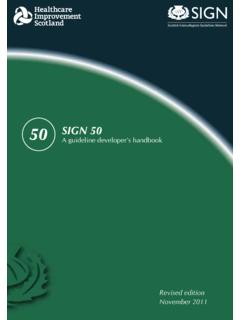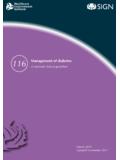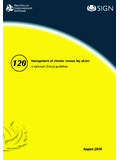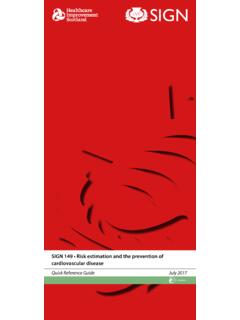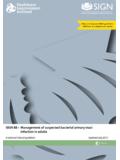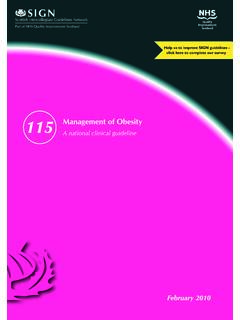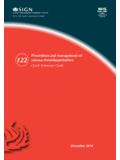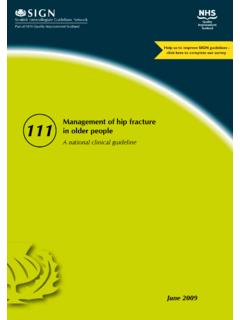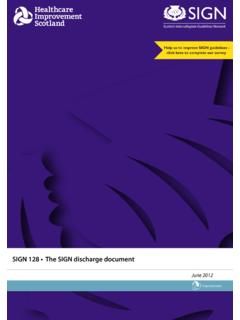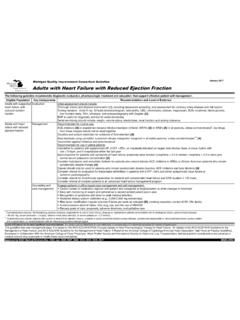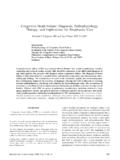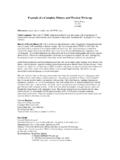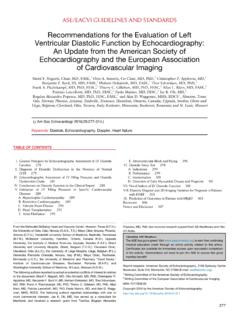Transcription of SIGN 147 • Management of chronic heart failure
1 SIGN 147 Management of chronic heart failureA national clinical guideline March 2016 Office | Gyle Square |1 South Gyle Crescent | Edinburgh | EH12 9EB Telephone 0131 623 4300 Fax 0131 623 4299 Glasgow Office | Delta House | 50 West Nile Street | Glasgow | G1 2 NPTelephone 0141 225 6999 Fax 0141 248 3776 The Healthcare Environment Inspectorate, the Scottish Health Council, the Scottish Health Technologies Group, the Scottish Intercollegiate Guidelines Network (SIGN) and the Scottish Medicines Consortium are key components of our organisation.
2 KEY TO EVIDENCE STATEMENTS AND RECOMMENDATIONSLEVELS OF EVIDENCE1++High-quality meta-analyses, systematic reviews of RCTs, or RCTs with a very low risk of bias1+Well-conducted meta-analyses, systematic reviews, or RCTs with a low risk of bias1 -Meta-analyses, systematic reviews, or RCTs with a high risk of bias2++ High-quality systematic reviews of case-control or cohort studies High-quality case-control or cohort studies with a very low risk of confounding or bias and a high probability that the relationship is causal2+Well-conducted case-control or cohort studies with a low risk of confounding or bias and a moderate probability that the relationship is causal2 - Case-control or cohort studies with a high risk of confounding or bias and a significant risk that the relationship is not causal3 Non-analytic
3 Studies, eg case reports, case series4 Expert opinionRECOMMENDATIONSSome recommendations can be made with more certainty than others. The wording used in the recommendations in this guideline denotes the certainty with which the recommendation is made (the strength of the recommendation).The strength of a recommendation takes into account the quality (level) of the evidence. Although higher-quality evidence is more likely to be associated with strong recommendations than lower-quality evidence, a particular level of quality does not automatically lead to a particular strength of factors that are taken into account when forming recommendations include: relevance to the NHS in Scotland; applicability of published evidence to the target population.
4 Consistency of the body of evidence, and the balance of benefits and harms of the strong recommendations on interventions that should be used, the guideline development group is confident that, for the vast majority of people, the intervention (or interventions) will do more good than harm. For strong recommendations on interventions that should not be used, the guideline development group is confident that, for the vast majority of people, the intervention (or interventions) will do more harm than conditional recommendations on interventions that should be considered , the guideline development group is confident that the intervention will do more good than harm for most patients.
5 The choice of intervention is therefore more likely to vary depending on a person s values and preferences, and so the healthcare professional should spend more time discussing the options with the POINTS Recommended best practice based on the clinical experience of the guideline development has accredited the process used by Scottish Intercollegiate Guidelines Network to produce clinical guidelines. The accreditation term is valid until 31 March 2020 and is applicable to guidance produced using the processes described SIGN 50: a guideline developer s handbook, 2015 edition ( ).
6 More information on accreditation can be viewed at Improvement Scotland (HIS) is committed to equality and diversity and assesses all its publications for likely impact on the six equality groups defined by age, disability, gender, race, religion/belief and sexual guidelines are produced using a standard methodology that has been equality impact assessed to ensure that these equality aims are addressed in every guideline. This methodology is set out in the current version of SIGN 50, our guideline manual, which can be found at The EQIA assessment of the manual can be seen at The full report in paper form and/or alternative format is available on request from the Healthcare Improvement Scotland Equality and Diversity care is taken to ensure that this publication is correct in every detail at the time of publication.
7 However, in the event of errors or omissions corrections will be published in the web version of this document, which is the definitive version at all times. This version can be found on our web site This document is produced from elemental chlorine-free material and is sourced from sustainable Intercollegiate Guidelines NetworkManagement of chronic heart failureA national clinical guidelineMarch 2016 Scottish Intercollegiate Guidelines Network Gyle Square, 1 South Gyle Crescent Edinburgh EH12 published March 2016 ISBN 978 1 909103 43 6 Citation textScottish Intercollegiate Guidelines Network (SIGN).
8 Management of chronic heart failure . Edinburgh: SIGN; 2016. (SIGN publication no. 147). [March 2016]. Available from URL: consents to the photocopying of this guideline for the purpose of implementation in of chronic heart failureContents1 Introduction .. The need for a guideline .. Remit of the guideline .. Statement of intent ..32 Key recommendations .. Diagnostic Emotional wellbeing and health behaviour change .. Pharmacological therapy .. Interventional procedures .. Discharge and anticipatory care planning.
9 Palliative care ..73 Diagnosis and investigations .. Diagnosing heart failure .. Determining the underlying cause of heart failure ..134 Emotional wellbeing and health behaviour change .. Depression .. Dietary Alcohol .. Smoking .. Exercise training programmes .. Unsupervised physical activity .. Complementary therapies ..175 Pharmacological therapies .. Beta blockers .. Angiotensin-converting enzyme inhibitors .. Angiotensin receptor blockers .. Mineralocorticoid receptor antagonists .. Angiotensin receptor/neprilysin inhibitors.
10 Ivabradine .. Diuretics/ loop diuretics .. Digoxin .. Natriuretic peptide-guided treatment .. Summary of the use of major drug classes for treatment of heart failure .. Antithrombotic therapy .. Hydralazine and isosorbide Phosphodiesterase inhibitors .. Patients with anaemia .. Patients with heart failure with preserved ejection fraction .. heart failure and gout .. heart failure and renal impairment .. heart failure and angina .. heart failure in frail older people .. Vaccinations ..29 Management of chronic heart failureContents6 Interventional procedures.
